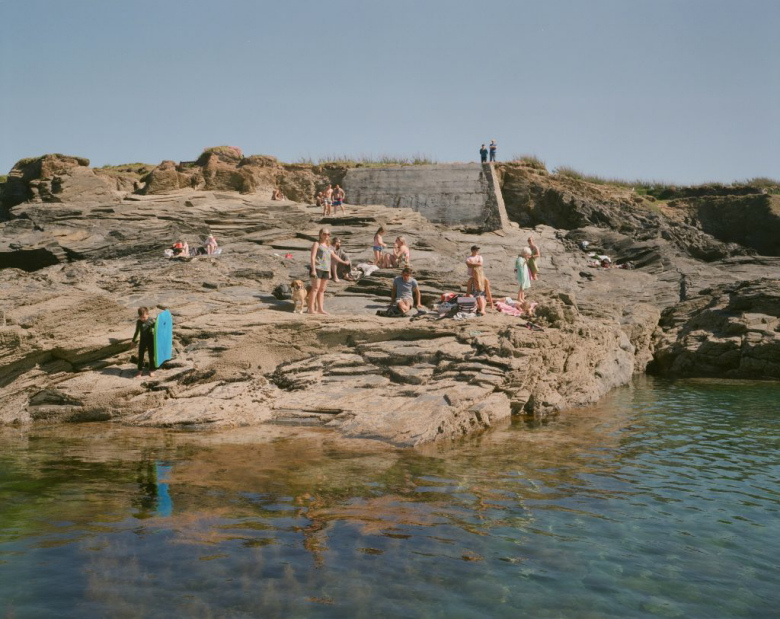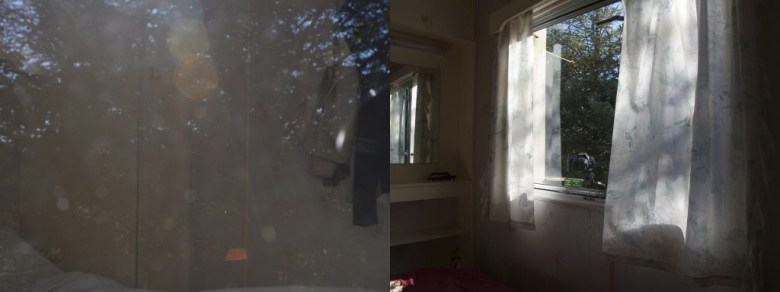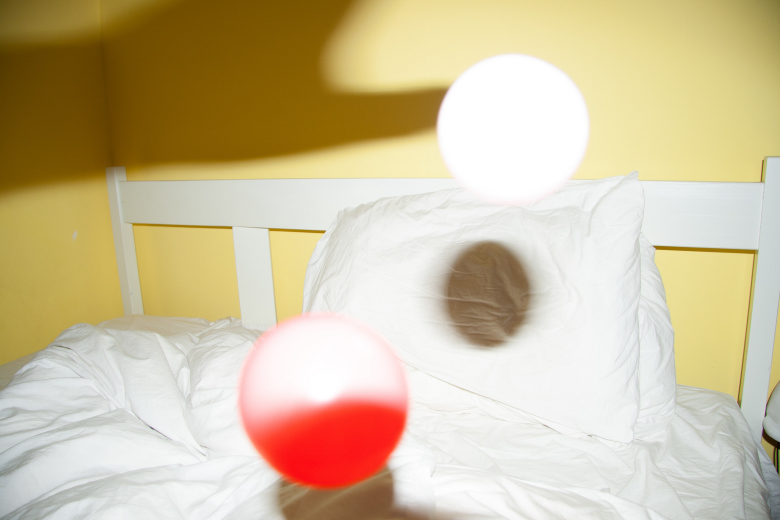|
|
| home | exhibitions | interviews | features | profiles | webprojects | archive |
|
A body, in parts, interjects Lizzie Lloyd on Melanie Stidolph
The only thing that is different from one time to another is what is seen and what is seen depends upon how everybody is doing everything. This makes the thing we are looking at very different and this makes what those who describe it make of it, it makes a composition, it confuses, it shows, it is, it looks, it likes it as it is, and this makes what is seen as it is seen. Gertrude Stein Actions proliferate in Melanie Stidolph’s work. Inside looking out: a bird alights; an apple falls; the bird is missing; a camera awaits. Inside looking in: a light flares; balls are thrown; a chair drops; an egg breaks; a shadow is cast; a balloon is punctured; a white orb glows, the same chair drops; another egg is thrown; light reflects. A light flashes; a shutter releases. Periodically a body, in parts, interjects: standing, reaching, holding, yielding. More bodies, outside this time: swimming, looking, sitting, paddling, drying, lying, clambering, searching. They laugh, chatter, call out. The camera waits. The camera waits. The camera waits. This chronicling of Stidolph’s work tells but part of the story. In my retelling I’m surely mixing things, my chronology awry: past moments bleed into present, future and imagined moments, their particularity dissolving though the action of repetition, reframing and looking again. My retelling here is another repetition of course, another way to make sense of the images, another attempt at reconfiguring them according to another kind of logic, in relation to another kind of life. All of which feels appropriate here. Take Endless Reproduction (2022), a photo book which features excerpts from older works, going as far back as 2011, and additions from hundreds of images not shared before. In her enfolding of earlier images into new works, you get the sense that she is looking back at previous images to reinhabit them, to see them afresh. That is after all a life, a series of experiences new and remembered that become subsumed by and re-imagined in the life we are living in the present.
This tendency toward the reflective also plays out in Last Summer (2017–ongoing (picture above)). As a series of shots of what I assume to be friends and families set at the seaside or on riverbank Last Summer rings out, at first sight, with rose-tinted nostalgia. Some of these images feature groups wholly absorbed in their pottering, others are taken at a distance their subjects unaware of being observed. Still others are more intimate, taken straight on, the protagonists sometimes making eye contact with the camera, welcoming the body behind the camera or the photograph into their worlds. You soon realise, though, that the bodies figured in these shots are rarely the same, that Last Summer is not a record of Stidolph’s own holidays but a bearing witness to the holidays of strangers. And the hazy views, muted tones and the odd pop of light-hearted summer colour become tinged, not with wistful recollection but something more loaded. Stidolph is open about her many years spent trying to get pregnant. She wants her work to be in dialogue with the matter of being childless by circumstance. Last Summer is a way of interrogating the idea of family, in all its guises, beyond the binary of having children or not having children. Stidolph’s repeated exposure to and sharing in the watery landscapes of families at leisure becomes an act of anthropological curiosity – she watches groups interact, registering how they behave individually and together, and also when she is close, how they respond to her and her camera. It is an act of careful circling, waiting, watching, returning, reflecting and re-framing.
As open as she is about her personal circumstances, at times, Stidolph pointedly subtracts herself from the work. Even the act of pressing the shutter feels too personal, too deliberate, too charged, too active. From around 2011 she began using automatic shutter release systems – the kind usually used by wildlife photographers to capture action shots of animals – so that control of the shutter is generated by external stimuli such as changes in sound, light, or movement. This further mechanising of the act of taking a photograph, an act already highly mediated by technology, has a variety of consequences. In Trigger (2011 - above)) a camera is set up on a ledge used to feed birds just outside the window of a caravan. Its lens, however, is turned not to the outside world as you might expect but to the window looking in. The shutter of the external camera is triggered by the alighting of birds on the ledge beside it but not, again as the technology is intended, to capture close-ups of the birds themselves. Instead Stidolph’s external camera takes a photo of a bedroom sometimes empty, sometimes featuring a figure holding another camera, and an unmade bed, all of which is partly obscured by bright light and nearby trees reflecting on the window. It’s a circuitous set up, suggesting an infinite feedback loop. And equivocal too. The scene is carefully staged but also nods towards objectivity and the documentary, the authentic and the fictional, leaving you unsure of the true subject of the image. Estate (2013) functions similarly, this time using a trigger in combination with flash. While an ostentatious bunch of flowers on a domestic table are filmed, an off-screen camera is hooked up to a trigger measuring the sound levels of the street outside. As the voices in the street increase the camera unleashes rapid shutter bursts alongside the firing of the camera’s flash creating intense fluctuations between strobe-like illumination and a pitch-black screen. The subject of the work is made slippery since that which is visible – the flowers – are only made visible by the environmental action on the street setting off the flash. The visible, then, becomes mere distraction, the work’s real action taking place off screen.
Such an exploration of visibility and concealment features strongly in Stidolph’s work. Like her deliberate misuse of triggers, her manipulation of light and shadow is used to divert attention, often even sabotaging the integrity of the image. Much of our understanding of light and shadow originates from Plato who saw light as synonymous with knowledge, shadow with ignorance, thereby creating an enduring hierarchy between the two. Plato’s famous myth tells of a group of prisoners shackled to a cave wall who are unable to look directly at the light behind them. They assume that the shadows thrown against the wall of the cave are ‘in all respects real’ rather than mere silhouettes.[1] The myth conceives of light as illuminating and clarifying, shadow as intrinsically lacking and constituting an absence of substance and knowledge. But Stidolph upends this. In Estate, for example, the violence of the flash estranges rather than clarifies, rendering the flowers monstrous not pretty, and drawing attention to a peripheral form rather than the main event (the voices in the street). In The Fall (2012 (above)) balls are repeatedly thrown or dropped against various backdrops – open kitchen cupboards, staircases, doorways, unmade beds – and captured using flash. In these works, the light of the flash frequently functions to obscure rather than reveal: it reflects off the shiny surface of the balls creating what look like holes in the image or flattens the rumpled bedsheets which only gain solidity through the articulation of cast shadows. This partial inversion of light and shadow is used, then, to disorientate and destabilise understanding. Repetitions, like the actions with which I began, proliferate in Stidolph’s work: cameras shoot cameras, glass reflects, light throws shadow, images return. They enact a deliberate picking apart of the mechanics of photography and the nature of Stidolph’s role in the process of image-making. She stages, she documents, she tampers, she observes, her body enters, then deflects. Her deliberate misuse of the tools and techniques of her trade enable this: triggers divert and flashes conceal. This misuse recalls another lover of repetitions, Gertrude Stein, who appears in the epigraph to this text. Her love of repetition was embodied in the circularity of her sentences that paid little heed to the conventions of grammar or syntax. ‘The only thing that is different from one time to another,’ Stein wrote, ‘is what is seen and what is seen depends upon how everybody is doing everything’. Repetition is a retrying, a remaking, a seeing anew.[2] [1] Plato, The Republic, 514a-16a translated by H.D.P. Lee, (London: Penguin Books, 1968), quoted in Victor I. Stoichita, A Short History of the Shadow (London: Reaktion Books, 1997) pp. 20–24. [2] Gertrude Stein, ‘Composition as Explanation’, in A Stein Reader, Ulla E. Dydo ed. (Evanston, Illinois: Northwestern University Press, 1996), p. 500.
'Endless Reproduction' is available here: https://melaniestidolph.com/work/endless-reproduction/ Melanie Stidolph's 'As It Is Seen' was at Grays Wharf in October 2022. The essay by Lizzie Lloyd was commissioned as part of Synesthesia, funded by Cultivator Cornwall. 8.11.22 |
|
|



